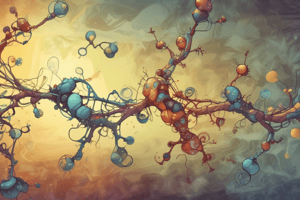Podcast
Questions and Answers
Natural selection, operating on the different ______ would have brought about subsequent evolutionary development.
Natural selection, operating on the different ______ would have brought about subsequent evolutionary development.
RNAs
As protobionts grew and split, their ______ passed on to offspring and with time, a diversity of ______ cells came into existence.
As protobionts grew and split, their ______ passed on to offspring and with time, a diversity of ______ cells came into existence.
The term “chemical evolution” was introduced by ______.
The term “chemical evolution” was introduced by ______.
Melvin Calvin
The building block molecules may have been synthesized in the ______, hydrosphere, or lithosphere of young Earth.
The building block molecules may have been synthesized in the ______, hydrosphere, or lithosphere of young Earth.
The BIG BANG theory suggests that all matter concentrated in a single ______ and blew apart.
The BIG BANG theory suggests that all matter concentrated in a single ______ and blew apart.
The peripheral matter formed its ______ after the BIG BANG.
The peripheral matter formed its ______ after the BIG BANG.
According to one theory, the building block molecules may not have been formed on Earth but brought from outer space by ______.
According to one theory, the building block molecules may not have been formed on Earth but brought from outer space by ______.
This is a self-limiting endeavor, so cells needed to evolve mechanisms for generating energy and synthesizing the molecules necessary for their ______.
This is a self-limiting endeavor, so cells needed to evolve mechanisms for generating energy and synthesizing the molecules necessary for their ______.
The mechanisms using ______ are thought to have evolved in 3 stages that correspond to glycolysis, photosynthesis and oxidative metabolism.
The mechanisms using ______ are thought to have evolved in 3 stages that correspond to glycolysis, photosynthesis and oxidative metabolism.
Glycolysis provided a mechanism by which the energy in preformed organic molecules (eg. glucose) could be converted to ______.
Glycolysis provided a mechanism by which the energy in preformed organic molecules (eg. glucose) could be converted to ______.
The development of ______ is generally thought to have been the next major evolutionary step – it allowed the cell to harness energy from sunlight, independent from the utilization of glucose.
The development of ______ is generally thought to have been the next major evolutionary step – it allowed the cell to harness energy from sunlight, independent from the utilization of glucose.
The release of ______ as a consequence of photosynthesis changed the environment in which cells evolved, leading to the development of oxidative metabolism.
The release of ______ as a consequence of photosynthesis changed the environment in which cells evolved, leading to the development of oxidative metabolism.
The four stages of chemical evolution are: Primitive environment, ______ synthesis, Protobiont synthesis, RNA synthesis.
The four stages of chemical evolution are: Primitive environment, ______ synthesis, Protobiont synthesis, RNA synthesis.
RNA sequences best suited to environmental parameters such as ______ and salt concentration would have survived.
RNA sequences best suited to environmental parameters such as ______ and salt concentration would have survived.
A critical characteristic of ______ is the ability to replicate itself.
A critical characteristic of ______ is the ability to replicate itself.
Only ______ acids can direct their self-replication.
Only ______ acids can direct their self-replication.
Nucleic acids can serve as templates for synthesis because of specific base pairings between ______ nucleotides.
Nucleic acids can serve as templates for synthesis because of specific base pairings between ______ nucleotides.




